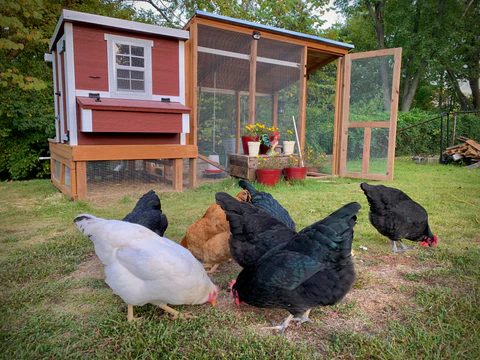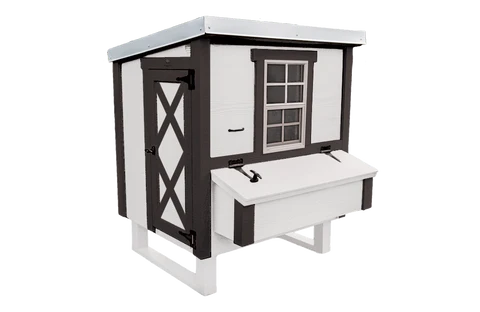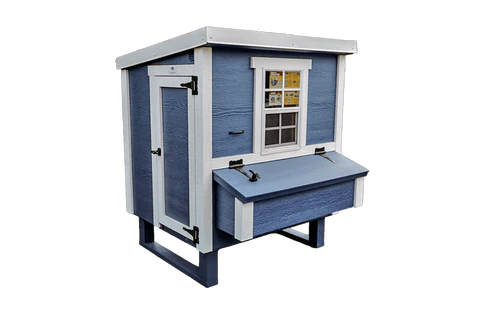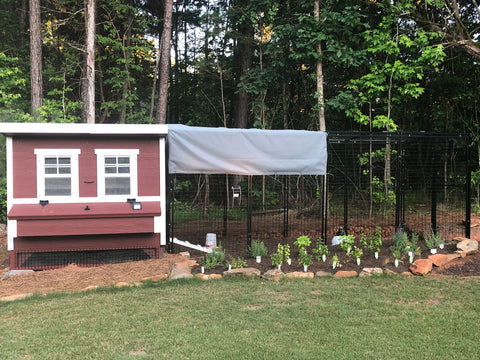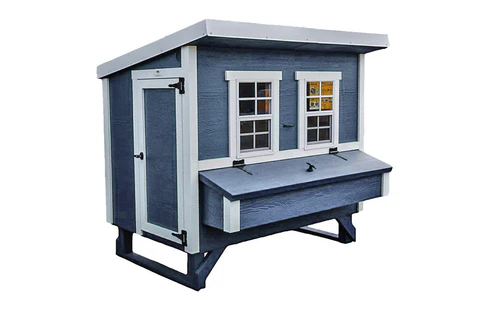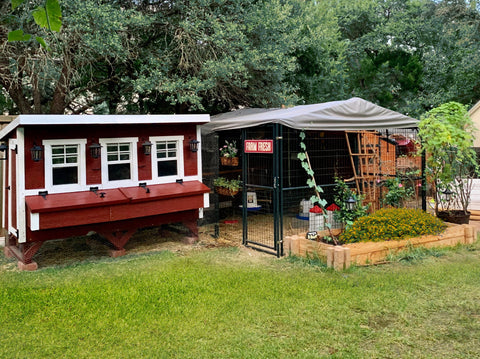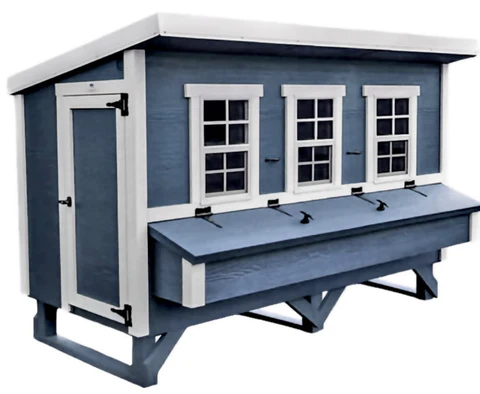Recently, there has been a growing focus on local food and sustainability. Which has spurred a renewed interest in raising chickens, especially in larger cities.
Depending on the purpose your chickens will serve whether that be for meat, eggs, or to have them as pets, there are many reasons and benefits to consider when raising chickens. The most popular purpose is to raise chickens for eggs or meat. However, many chicken owners choose to raise them strictly as pets. Chickens are generally friendly, entertaining, and easy to manage, which makes them great pets.
Choosing a Chicken Breed
 Depending on the reason behind your choice to raise chickens, this will determine the chicken breed you choose.
Depending on the reason behind your choice to raise chickens, this will determine the chicken breed you choose.
If your primary reason for raising chickens is fresh eggs, then choosing a breed with high egg production is important. The most popular breeds known for high egg production are Leghorns, Golden or Silver Campines, Buttercups, Hamburgs, Blue Andalusians, or Minorcas.
If you are wanting to raise chickens for their meat, then it is important to choose a bigger chicken breed that is known for having lots of meat. The most popular breed is the Cornish Cross, which is a fast-growing hybrid with a plump breast.
If you are just starting out and are unsure of the purpose you want your chickens to ultimately serve, then choosing a dual-purpose breed would be the best choice. Dual-purpose breeds include Brahams, Cochins, New Hampshire, and Rhode Island Reds, Wyandottes, Ameraucanas, Barred Rocks, or Buff Orpingtons.
How Many Chickens You Should Start With
Chickens are very sociable, so it is best to have at least 3 chickens. After some time and experience, you can decide if you want to add more chickens to your flock. Introducing new chickens to your flock is also something new chicken owners need to consider.
How to Introduce New Chickens to Your Flock
If you are wanting to introduce new chickens to your flock, there are a few things you need to consider to make the transition smooth.
Number of Chickens
The number of chickens you introduce will matter. If you are introducing only one chicken, it’s a good idea to introduce them in pairs. It can be intimidating for one chicken to face a new flock alone. Introducing in pairs will help ensure that the new chicken is not isolated by the rest of the flock.
Size and Age
Introduce chickens of the same size and age. Smaller birds may be an easy target for bullying from the rest of the flock.
Keep New Chickens Separate
Put new chickens near your existing flock, but separate. Perhaps putting them in a fenced area outside of the run. This will allow your existing flock to see the new chickens without them feeling like the new chickens are invading their space.
Pecking Order
Naturally chickens develop a pecking order, so introducing new chickens to your existing flock can sometimes be a challenge until a new pecking order is established.
The most important aspect of introducing new chickens to your flock is keeping an eye on the newcomers to ensure the introduction and transition goes smoothly.
Choosing a Chicken Coop
One of the most important decisions when it comes to raising chickens is choosing a chicken coop. Proper housing is essential in raising a healthy flock. A chicken coop protects your chickens from predators and the elements and it gives them a warm, comfortable place to roost.
There are many decisions surrounding the chicken coop you ultimately choose. For example, choosing the type of coop you want, whether that be a DIY coop, a custom coop, or a prefabricated coop.
DIY Chicken Coops
Building your own chicken coop allows you to tailor your chicken coop for your and your flock’s needs. You can construct it to fit your style and function, which is nice, however, it is not always the best option. Building a chicken coop takes proper knowledge, time, and tools.
If you are a first-time chicken owner, this task might be a bit too daunting. Especially when considering the several factors of a chicken coop’s purpose like predator protection, the temperature in the coop, spacing for chickens, etc.
Custom Chicken Coops
If your budget allows, custom chicken coops are another option. This is popular for those looking to build a chicken coop to their own specifications. However, many options on the market will cost you a lot more money, are much bulkier, and are hard to assemble, which is not great for raising chickens in your backyard.
Prefabricated Chicken Coops
Chicken Coops Delivered offers one of the best chicken coop options on the market. After many years of seeing chicken owners have less than ideal chicken coop options, we invented Chicken Coops Delivered.
Our coops are really easy to ship, assemble, and move around your backyard. Chicken Coops Delivered meet the highest quality standards compared to custom-built chicken coops. This is because of the Amish craftsmanship and high-quality materials.
We offer several sizes of chicken coops that comfortably house flock sizes of 5 to 30 chickens.
Coop in a Box
The Chicken Coop in a Box is a fantastic starter kit. It houses up to 5 chickens and also includes an attached run and panels.
Assembly is easy! All panels and trim are painted and assembled, hardware, doors, windows, and nesting boxes are installed, and metal is installed on the roof panel.
Product features include:
- 1 screened window
- 2 nesting boxes
- 2 vents
- 2 roosts
- 1 mandoor
- 1 chicken door with a treated wood ramp
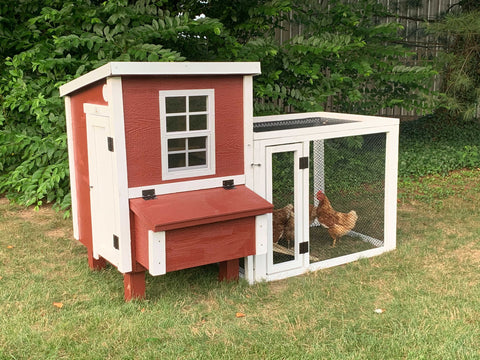
Small Chicken Coop
The Small Chicken Coop comfortably houses up to 5 chickens. This chicken coop is heavy-duty and quality-made and can be used in cold winter months and hot months.
Product features include:
- 1 screened window
- 2 nesting boxes
- 2 vents
- 2 roosts
- 1 mandoor
- 1 chicken door with a treated wood ramp
- Flooring and siding has a treated resin
- Roof profile is designed so that rainwater runs off the back of the chicken coop
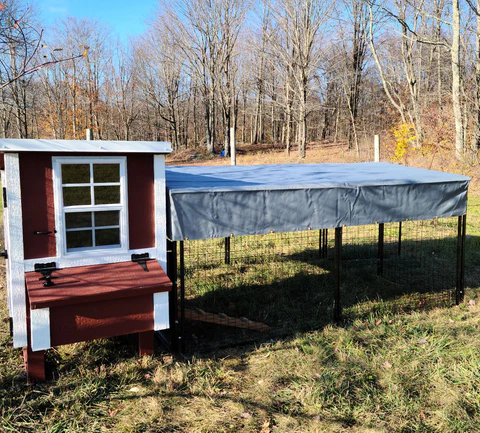
Medium Chicken Coop
The Medium Chicken Coop is the perfect size for a flock of 10 chickens. Assembles in less than 60 minutes with only a screw gun. It can be used in hot and cold climates and is heavy-duty. In addition to our Medium Classic Red Chicken Coop, our Medium Chicken Coop is available in Farmhouse and Coastal styles.
Product features include:
- 1 screened window
- 3 nesting boxes
- 2 vents
- 2 roosts
- 1 mandoor
- 1 chicken door with treated wood ramp
- Flooring and siding has a treated resin
- Roof profile is designed so that rainwater runs off the back of the chicken coop
Large Chicken Coop
The Large Chicken Coop is our best value and comfortably houses up to 15 chickens. All parts needed for assembly are included, making it easy to assemble in less than 60 minutes with only a screw gun. In addition to our Large Classic Red Chicken Coop, our Large Chicken Coop is available in Farmhouse and Coastal styles.
Product features include:
- 2 screened windows
- 5 nesting boxes
- 2 vents
- 2 roosts
- 1 mandoor
- 1 chicken door with a treated wood ramp
- Flooring and siding has a treated resin
- Roof profile is designed so that rainwater runs off the back of the chicken coop
XL Chicken Coop
The XL Chicken Coop is perfect for a flock of 20 chickens. Assembly takes less than 60 minutes with only a screw gun. It is heavy-duty and can be used in hot and cold climates. In addition to our XL Classic Red Chicken Coop, our XL Chicken Coop is available in Farmhouse and Coastal styles.
Product features include:
- 3 screened windows
- 6 nesting boxes
- 2 vents
- 2 roosts
- 1 mandoor
- 1 chicken door with treated wood ramp
- Flooring and siding has a treated resin
- Roof profile is designed so that rainwater runs off the back of the chicken coop
Jumbo Chicken Coop
The Jumbo Chicken Coop is our biggest coop and is perfect for a flock of 30 chickens. It is built to last, and is designed for use in both hot and cold climates. Assembly takes 60 minutes with only 3 people and a screw gun.
Product features include:
- 4 screened windows; windows open and close for fresh air
- 10 nesting boxes
- 2 vents
- 2 roosts
- 1 mandoor
- 1 chicken door with treated wood ramp
- Flooring and siding has a treated resin
- Roof profile is designed so that rainwater runs off the back of the chicken coop
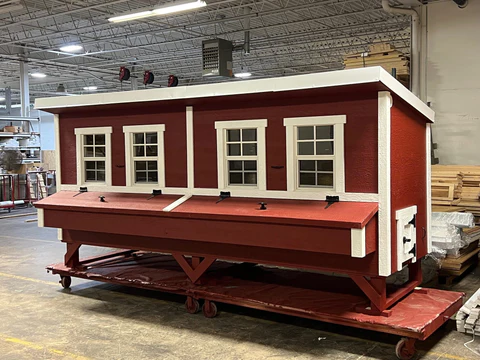
Important Things to Consider When Choosing a Chicken Coop
Chickens Need Space
The amount of space you will need depends on how you plan to keep your chickens. If your flock will have plenty of outdoor space, then you should plan to have at least 10 square feet of outdoor space per chicken. However, there is no limit to the space you can provide. The more space provided, the better.
Generally, we encourage chicken owners to choose a bigger chicken coop, or at least the biggest chicken coop that they have space for. As with outdoor space, if you can provide it, the more the better. Chickens can get aggressive with one another if they are kept in close proximity for long periods of time.
Security
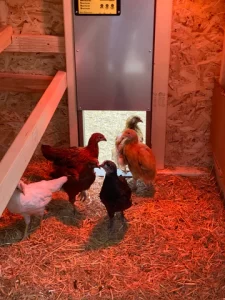 The security of your chicken coop is critical for the safety of your flock. Ensure that the coop you build or buy has locking doors. If you purchase an automatic door, timers are designed to open in the morning and close at night. This allows you to ensure the coop closes and opens when you want it to.
The security of your chicken coop is critical for the safety of your flock. Ensure that the coop you build or buy has locking doors. If you purchase an automatic door, timers are designed to open in the morning and close at night. This allows you to ensure the coop closes and opens when you want it to.
Electricity and Heat
This is nice to have for your chickens because they can withstand cold weather on their own. The main reason to consider heating a coop is to keep the water from freezing. Adding light to your chicken coop is also not a necessity, but it can encourage egg production when the days grow shorter. To encourage your chickens to continue to lay eggs in colder months, keep a light source on for 13-14 hours.
Ventilation
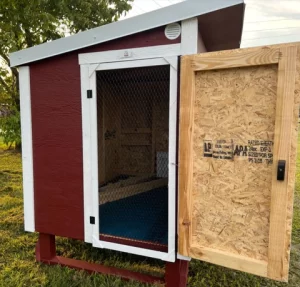 In hotter months, ventilation in the chicken coop is extremely important for your flock. The Chicken Coop Ventilation Door is the perfect way to add additional airflow to your chicken coop, and your flock will really appreciate it on warm days!
In hotter months, ventilation in the chicken coop is extremely important for your flock. The Chicken Coop Ventilation Door is the perfect way to add additional airflow to your chicken coop, and your flock will really appreciate it on warm days!
Run Space
 When your chickens are feeling cooped up, chicken runs give them the fresh air, and security they need. Chicken runs are a wire-mesh enclosure that protects chickens from predators. Make sure the chicken run you choose is sturdy and offers plenty of space for your flock to roam.
When your chickens are feeling cooped up, chicken runs give them the fresh air, and security they need. Chicken runs are a wire-mesh enclosure that protects chickens from predators. Make sure the chicken run you choose is sturdy and offers plenty of space for your flock to roam.
Roosting Area and Nesting Boxes
 A roosting area is an elevated perch where chickens rest and sleep. They keep chickens safer from predators at night, while also keeping them safe from harmful pests on the coop floor, such as lice and mites.
A roosting area is an elevated perch where chickens rest and sleep. They keep chickens safer from predators at night, while also keeping them safe from harmful pests on the coop floor, such as lice and mites.
They should be made with a sturdy material and at least 2 inches wide. Unlike other birds, chickens do not wrap their feet around objects to sleep, they actually sleep flat footed.
 All Chicken Coops are equipped with 2 roosting bars, so your chickens will have the perfect place to roost at night.
All Chicken Coops are equipped with 2 roosting bars, so your chickens will have the perfect place to roost at night.
Keeping the Coop Pest Free
The design of your chicken coop is an important part of keeping rodents and insects away. Making your chicken’s home a place that is not attractive to rats consists of a few elements, including a coop that sits off the ground, proper food/water storage, and more.
It is important to prevent rats and mice from digging. If they can easily dig under your coop they will be able to infest it much easier. One way to prevent this behavior is to have a coop that is off the ground. All chicken coops are designed to sit off the ground.
Additionally, there are other measures you can take to prevent pests from being attracted to the chicken coop.
Food storage is the most important element to keeping pests away from your chickens and coop. If you store extra food outside next to your coop, make sure to use a metal container, and also have a tight-fitting lid.
Water storage is another key element in keeping pests away from your flock. Rats are easily attracted to sources of water. One of the best ways to keep rats from coming to your chicken’s water is to put all water sources away at night.
Protect your chicken coop by covering ventilation areas and any existing holes. Automatic Chicken Coop Doors can also help with closing access points to your coop after your flock has roosted for the night. Additionally, it is important to clean your coop and your flock’s area as regularly as possible.
Chicken Nutrition
Chicken Feed
To keep your chickens plump and happy, you will need a chicken feeder and quality chicken feed. Fill the canister with store-bought chicken layer pellets. To make sure your chickens are getting the nutrition and variety they need, you should also supplement your chicken feed with cracked corn and bugs. One option is to allow them to forage themselves.
A popular option within the chicken-keeping community is to give your chickens fruit and vegetables from your own kitchen. They will even eat cooked beans and pasta if you do not mind cooking for your flock.
Additionally, you will need a feeder. There are many feeder options on the market including Gravity, Automatic, Hanging, and more. It is important to consider the durability and size of the feeder.
The Chicken Feeder holds up to 50 LBS of feed! It is a convenient solution to feeding chickens 12 weeks and older for up to 45 days. Featuring a no-waste, gravity-fed design, port over hang to prevent water from leaking into feed, wide mouth opening, and more. It allows 3 chickens to feed at once. This feeder is durable and constructed with UV-protected, food-safe, BPA-free, recyclable plastic.
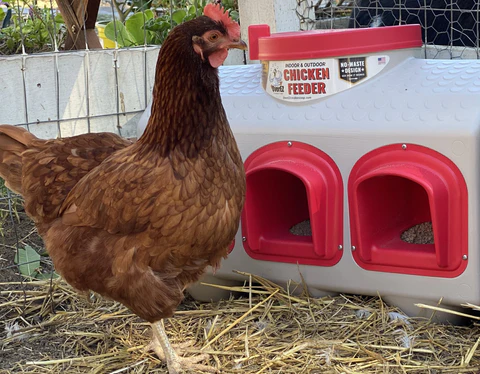
Water
Chickens need a regular supply of fresh, clean water. You can use a 5-gallon bucket or a shallow plastic dish. There are also several automatic watering systems that ensure your chickens are never parched.
The Chicken Waterer holds 12 gallons of water and provides clean water for up to a month! It is durable, made to last, and comes equipped with a power cord access port. Additionally, it is constructed with UV-protected, food-safe, BPA-free, recyclable plastic.
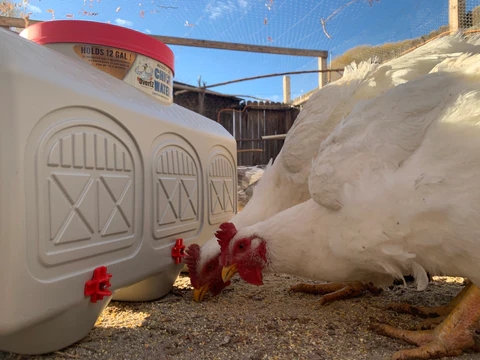
Caring For Chickens
Another important aspect of raising chickens is recognizing when there might be something wrong with your flock.
Oftentimes, it can be difficult to tell if your chickens are sick. Especially because they are very good at hiding it. As chicken owners, it is important to try and recognize early signs before it is too late.
Signs A Chicken is Sick
There are a few signs you can examine, including:
- How the chicken interacts with the rest of the flock
- How the flock interacts with the chicken
- Appearance of feathers
- Combs and Wattles
- Eyes/noses/mouths/beaks
- The breast muscles
- The abdomen
How The Flock and Chicken Interacts
One sign that may indicate a chicken is sick, is if the chicken starts distancing itself from the rest of the flock. Sometimes, they are the last to leave the coop in the mornings, or will not roost at night. Additionally, they may not peck around with the other chickens.
Not only is it important to see how the chicken interacts with the flock, but it is is also important to see how the flock interacts with the chicken. Pay close attention to this dynamic because it can be a pretty telling sign. If it seems like they are picking on that chicken, it could be because they are not acting normally, or the chicken is acting weak.
Another important thing to check for if a chicken is behaving that way, is that she is not broody. You can test this by removing her from the nest, and watch her behavior. If she acts like she normally would, eats, drinks, and pecks, then she could be broody. Especially if she is eager to return to her nesting box.
Feathers
Examine your chicken’s feathers. If all the feathers on a chicken’s shoulders look matted it could be a sign of a sinus infection. If their nose is running, they will wipe it on their shoulders.
Feathers that are dirty around the vent mean the abdomen is swollen, or the chicken has too much urine/diarrhea.
Combs and Wattles
A chicken’s comb and wattle should look waxy and plump. If combs or wattles look shriveled and dry, it is a good indication that they are sick.
Eyes
Chicken’s eyes should look round and shiny. They should not be bubbly or watery.
Noses
A chicken’s nose should be dry with nothing plugging up its nares. One way to test a chicken’s nose is by holding its beak closed and listening to the way it breathes. Listen for dry puffs of air. There should be no wheezing or whistling noises.
Mouths
Chicken’s mouths should be moist and pink. However, they should not be excessively wet.
Breast Muscles
This can be a tricky one to test. One tip for checking a chicken’s breast muscles is to compare it with another chicken of the same breed. If the center keel bone is sharper with smaller pads of muscle on either side, it means the chicken is too thin.
Abdomen
If a chicken is an egg-laying hen, its abdomen should feel rounded and soft. Roosters, cockerels, pullets, or non-egg-laying hens should have a firm abdomen.
If a chicken’s abdomen feels round and hard, that is usually a sign that something is wrong.
If a Chicken is Sick
If you do discover that a chicken is sick, make sure that no other chickens in your flock are showing the same symptoms. If they are showing similar symptoms, it means that the illness has spread through your flock.
There are different measures you can take for helping a chicken that is sick. It truly matters on the type of sickness.
Generally, though, there are some important things you can do to help a sick chicken, including:
- Isolate the sick chicken. This ensures that the chicken will not get picked on, as well as it protects the rest of the flock from getting the same illness.
- Ensure that your chicken is properly hydrated.
- Ensure that your chicken is getting food. You can provide them with digestive support supplements as well. However, if a chicken is eating and drinking properly, do not give them food/supplements they are not used to.
- Make sure that you properly treat the chicken. Do not treat the illness without knowing exactly what it is.
Check out Marilyn’s Guide to Backyard Chickens!
Have additional tips for raising chickens? Let us know in the comments!
RELATED ARTICLES
Tips For Protecting Chickens In Cold Weather
With the winter months upon us, it is a good time to think about how you are keeping your chickens warm and comfy, even on days when the mercury hovers at or below zero. With the right preparation and a little extra effort, you can rest assured that your chicken flock...


